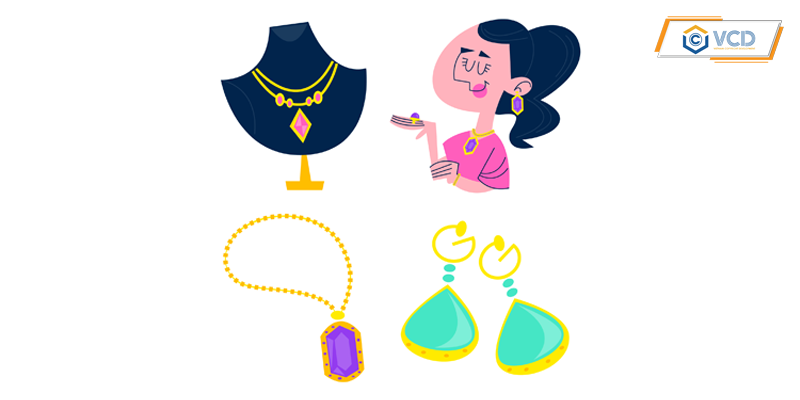If someone hires someone to design a jewelry model, who owns the copyright?
Jewelry design is not only an art but also a valuable intellectual property. Many businesses, brands or individuals choose to hire a designer or a jewelry design unit instead of creating their own. However, when hiring a designer, who owns the copyright of the jewelry design, the hirer or the designer? Let’s find out more in the article below with VCD to avoid unnecessary legal risks.
- Are jewelry designs protected by copyright?
According to the Vietnamese Intellectual Property Law, works of applied art – including jewelry designs, accessories, and handicraft products – are all subject to copyright protection if they meet two conditions:
- Have creativity and a unique mark, not copied from other works.
- Expressed in a specific material form, such as a drawing, 3D model, CAD design or finished product sample.
Thus, each sketch, design drawing or jewelry sample is considered a creative work, and the creator will be recognized as the author by default by law, unless there is another agreement on ownership.
2. If someone hires someone to design a jewelry model, who owns the copyright?
This is a point that often causes confusion between “copyright” and “ownership of the work”. When you hire someone else to design jewelry, it is important to understand that: The person who directly creates the design (the designer) is still recognized by law as the author of the work. However, the copyright ownership, that is, the right to use, exploit, distribute or transfer the design, will belong to the lessee, if there is a contract between the two parties for hiring the creation of the work and it clearly stipulates the transfer of ownership.
This is specifically stipulated in Article 41 of the 2022 Intellectual Property Law: “The organization or individual to whom one, some or all of the rights are transferred as agreed in the contract is the copyright owner.”
If you hire a designer to create a jewelry design, you (the hirer) will be the copyright owner of that design if there is a written contract stating that all ownership of the work (including the right to copy, produce, and distribute) is transferred to you upon completion.
On the contrary, if there is no clear contract, the designer will still retain the copyright and ownership, while you only have the right to use the design within the scope of the verbal agreement or payment of the fee, which can easily lead to disputes later.

3. Risks of not clearly stating ownership in the design contract
In reality, many small businesses, workshops or individuals starting a business in the jewelry industry ignore this legal factor. The possible consequences of not clearly defining ownership in the design contract are:
- The designer retains the right to publish or resell the design to others, because you do not have a document proving ownership.
- The jewelry design is copied or copyrighted first, causing you to lose the right to exploit the product you ordered to design.
- Difficulty in registering copyright or industrial design protection, because you cannot prove that you are the legal owner.
- Commercial disputes occur when the design is used for mass production without a clear agreement on rights and profits.
Therefore, signing a detailed and legal design contract is mandatory if you want to protect your rights in the long term.
4. How to ensure copyright ownership when hiring a designer?
To avoid the above risks, businesses or individuals hiring designers should note the following important things:
- Sign a clear contract with a clause on ownership transfer. The contract must clearly state that the designer creates the model according to the request of the lessee. After handover, all ownership and exploitation rights of the design belong to the lessee. The designer is not allowed to use, edit, resell or share the model with a third party.
- Keep payment records and documents: Receipts, invoices, email exchanges, original sketches, etc. are evidence of the creative rental relationship, helping to protect your rights if a dispute arises.
- Register copyright or industrial design early: After receiving the design, you should register for protection at the Copyright Office or the Intellectual Property Office. This helps confirm that you are the legal owner and have a clear legal basis when there is an act of copying or infringement.
- Reuse or credit agreement: If you want to maintain a good working relationship, you can allow the designer to retain the right to credit the author, or display the design in a personal portfolio, as long as it is not used for commercial purposes.
Above is the article “If someone hires someone to design a jewelry model who owns the copyright?” compiled and shared by VCD. To avoid disputes and protect creative value, always sign a written contract, clearly stating rights and obligations, and register for protection for your designs early.
Sincerely,
To ensure legal ownership, a business needs to:
*Sign a written design contract, which clearly stipulates:
– The designer transfers all property rights (copyrights, distribution, production, trade, etc.) to the business.
– The business has the exclusive right to use, register copyright, and commercially exploit that design.
– The remuneration, payment method, and time of transfer of ownership.
*Register copyright/design rights at the Copyright Office (Ministry of Culture, Sports and Tourism) as a legal basis in case of dispute.
*Keep design documents, contracts, and original products to prove ownership.
Yes. If the business has been transferred property rights under the contract, any act of using, copying, transferring, or reselling that design by the designer is considered an infringement of copyright under Article 28 of the Intellectual Property Law 2022.
Depending on the level of violation, the designer may be subject to administrative sanctions, civil compensation, or criminal prosecution if causing serious damage to the business.
